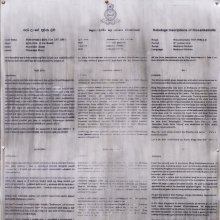Sarvangasundari, Sarvāṅgasundarī, Sarvamgasumdari: 8 definitions
Introduction:
Sarvangasundari means something in Hinduism, Sanskrit. If you want to know the exact meaning, history, etymology or English translation of this term then check out the descriptions on this page. Add your comment or reference to a book if you want to contribute to this summary article.
Images (photo gallery)
In Hinduism
Purana and Itihasa (epic history)
Source: archive.org: Shiva Purana - English TranslationSarvāṅgasundarī (सर्वाङ्गसुन्दरी) refers to “she who is exquisitely beautiful in every limb”, according to the Śivapurāṇa 2.5.14 (“The birth of Jalandhara and his marriage”).—Accordingly, as Brahmā said to the Ocean: “[...] This boy will become the emperor of Asuras. He will conquer even Viṣṇu. He will face defeat from no quarter. He cannot be slain by any one except Śiva. He will return to the place from where he sprang up. His wife will be a chaste lady who will increase good fortune. She will be exquisitely beautiful in every limb (sarvāṅgasundarī). She will be an ocean of good conduct and will speak pleasing words”.
Source: Cologne Digital Sanskrit Dictionaries: The Purana IndexSarvāṅgasundarī (सर्वाङ्गसुन्दरी).—A Devī in the Binducakra.*
- * Brahmāṇḍa-purāṇa IV. 19. 40; 36. 89; 44. 135.

The Purana (पुराण, purāṇas) refers to Sanskrit literature preserving ancient India’s vast cultural history, including historical legends, religious ceremonies, various arts and sciences. The eighteen mahapuranas total over 400,000 shlokas (metrical couplets) and date to at least several centuries BCE.
Ayurveda (science of life)
Source: archive.org: Vagbhata’s Ashtanga Hridaya Samhita (first 5 chapters)Sarvāṅgasundarī (सर्वाङ्गसुन्दरी) or Sundarā by Aruṇadatta is the name of a commentary on the Aṣṭāṅgahṛdayasaṃhitā: one of the three great works of Vāgbhaṭa.—The Aṣṭāṅgahṛdayasaṃhitā consists only of verses. The eight-fold division is observed in the Aṣṭāṅgahṛdayasaṃhitā too, though not as strictly as in the Aṣṭāṅgasaṃgraha. Numerous commentaries on the Aṣṭāṅgahṛdayasaṃhitā [viz., the Sarvāṅgasundarī], many of them unedited so far, can be traced in manuscripts, catalogues, publishers’ lists, etc.

Āyurveda (आयुर्वेद, ayurveda) is a branch of Indian science dealing with medicine, herbalism, taxology, anatomy, surgery, alchemy and related topics. Traditional practice of Āyurveda in ancient India dates back to at least the first millenium BC. Literature is commonly written in Sanskrit using various poetic metres.
Shaktism (Shakta philosophy)
Source: Brill: Śaivism and the Tantric Traditions (shaktism)Sarvāṅgasundarī (सर्वाङ्गसुन्दरी) refers to one of ten Kula Goddesses (kuleśvarī), according to the Kāmasiddhi-stuti (also Vāmakeśvarī-stuti) and the Vāmakeśvaratantra (also known as Nityāṣoḍaśikārṇava).—[...] The next four verses, 17–20 [of the Kāmasiddhistuti], respectively praise the set of ten Kula goddesses (kuleśvarī). The list can be completed with the help of the Vāmakeśvaratantra (1.169-171), but these goddesses [i.e., Sarvāṅgasundarī] are here simply called śaktis.

Shakta (शाक्त, śākta) or Shaktism (śāktism) represents a tradition of Hinduism where the Goddess (Devi) is revered and worshipped. Shakta literature includes a range of scriptures, including various Agamas and Tantras, although its roots may be traced back to the Vedas.
Languages of India and abroad
Sanskrit dictionary
Source: Cologne Digital Sanskrit Dictionaries: Aufrecht Catalogus Catalogorum1) Sarvāṅgasundarī (सर्वाङ्गसुन्दरी) as mentioned in Aufrecht’s Catalogus Catalogorum:—Aṣṭāṅgahṛdayaṭīkā by Aruṇadatta.
2) Sarvāṅgasundarī (सर्वाङ्गसुन्दरी):—Gītagovindaṭīkā by Nārāyaṇadāsa.
Source: Cologne Digital Sanskrit Dictionaries: Monier-Williams Sanskrit-English DictionarySarvāṅgasundarī (सर्वाङ्गसुन्दरी):—[=sarvāṅga-sundarī] [from sarvāṅga-sundara > sarvāṅga > sarva] f. Name of various Comms.
[Sanskrit to German]
Sanskrit, also spelled संस्कृतम् (saṃskṛtam), is an ancient language of India commonly seen as the grandmother of the Indo-European language family (even English!). Closely allied with Prakrit and Pali, Sanskrit is more exhaustive in both grammar and terms and has the most extensive collection of literature in the world, greatly surpassing its sister-languages Greek and Latin.
Kannada-English dictionary
Source: Alar: Kannada-English corpusSarvāṃgasuṃdari (ಸರ್ವಾಂಗಸುಂದರಿ):—[noun] a woman who has a perfectly beautiful body.
Kannada is a Dravidian language (as opposed to the Indo-European language family) mainly spoken in the southwestern region of India.
See also (Relevant definitions)
Partial matches: Sundari, Sarvanga.
Full-text: Arunadatta, Mrigankadatta, Sundara, Kuleshvari, Ashtangahridayasamhita, Gitagovinda.
Relevant text
Search found 5 books and stories containing Sarvangasundari, Sarvāṅgasundarī, Sarvanga-sundari, Sarvāṅga-sundarī, Sarvamgasumdari, Sarvāṃgasuṃdari, Sarvāṅgasundari, Sarvāngasundari, Sarvānga-sundari; (plurals include: Sarvangasundaris, Sarvāṅgasundarīs, sundaris, sundarīs, Sarvamgasumdaris, Sarvāṃgasuṃdaris, Sarvāṅgasundaris, Sarvāngasundaris). You can also click to the full overview containing English textual excerpts. Below are direct links for the most relevant articles:
Bhagavatpadabhyudaya by Lakshmana Suri (study) (by Lathika M. P.)
Tāntric Measures < [Chapter 3 - References to Śaṅkara’s Philosophy]
Kuntaka’s evaluation of Sanskrit literature (by Nikitha. M)
6. Vikramorvaśīya in Kuntaka’s treatment < [Chapter 2 - Kuntaka’s appraisal of Kālidāsa]
Lalitopakhyana (Lalita Mahatmya) (by G.V. Tagare)
Chapter 43 - Types of Initiation and True Service of the Preceptor
Chapter 36 - The Inner Chamber of Cintāmaṇi
A History of Indian Philosophy Volume 2 (by Surendranath Dasgupta)
Part 18 - Āyurveda Literature < [Chapter XIII - Speculations in the Medical Schools]

